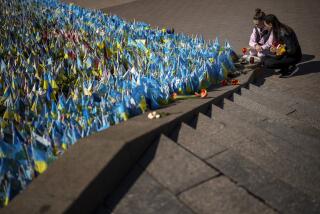Sakharov Buried Amid Calls for Party Reform
- Share via
MOSCOW — President Mikhail S. Gorbachev bowed his head in tribute Monday over the body of Andrei D. Sakharov and, in a memorial service that involved politics as well as sorrow, speaker after speaker called on the country to unite behind Sakharov’s efforts to speed up reform and end the Communist Party’s monopoly on power.
Sakharov then was buried at dusk in a 19th-Century Russian Orthodox cemetery, with mourners vowing that his ideals will live on. His widow, Yelena Bonner, leaned over his body and kissed his forehead one last time.
It was the culmination of four days of a massive show of public grief in the capital over Sakharov’s death, including religious services in Russian Orthodox cathedrals, private gatherings among friends in their homes and unusually extensive reports on Soviet television and Moscow Radio.
Monday’s ceremonies carried clear political overtones, with progressive members of the Congress of People’s Deputies, the nation’s national assembly, seeking to channel the grief and make the human rights campaigner and Nobel Peace Prize winner a symbol for the opposition.
Many of the mourners wore signs protesting Article 6 of the constitution, which guarantees the Communist Party’s domination of Soviet society. Others carried small icon-like photographs of Sakharov or wore black ribbons.
Before his death last Thursday at age 68, Sakharov led reformist deputies in an effort to place the issue of Article 6 on the agenda of the current session of the Congress. But his appeal was rejected last week after Gorbachev spoke forcefully against the proposal.
At the time of his death, Sakharov was working on a speech he hoped to give in the Congress, urging again that the issue be debated.
“Sakharov was the initiator of perestroika 20 years before Gorbachev became leader of the Communist Party,” said one mourner, 48-year-old mathematician Bella Belienkaya, using the word for Gorbachev’s reform program. “Without Sakharov to push Gorbachev, reform will move much more slowly.”
Legislator Yuri Afanyasev called for setting up a special organization named after Sakharov to push for change. “We’ve got to stop the Communist Party’s political monopoly,” Afanyasev told the estimated 50,000 mourners gathered in Luzhniki Park beside the Moscow River. “We’ve got to get rid of unpopular state socialism and move towards democratic socialism.”
Sakharov “did all he could. Now only his ideas can change things, and only we can fulfill his ideas,” said Iliya Zaslavsky, a deputy from Moscow.
“The best wreath for Andrei Dmitrievich Sakharov is to beat the conservatives in the March elections,” economist Gavril Popov told the mourners.
Gleb Yakunin, a priest who has opposed the Communist government, said that Sakharov deserves credit for reforms sweeping Eastern Europe.
“He brought us the freedom which has allowed our Slavic brothers to raise the Iron Curtain over our countries,” he told the crowd. “Andrei Dmitrievich started what seemed to be a hopeless cause--the struggle against totalitarianism--but which is now victorious.”
“Forgive Us. We Should Have Taken to the Squares in 1980,” read one banner held above the crowd, a reference to the year that Sakharov was sent into exile in the interior city of Gorky for opposing the Soviet invasion of Afghanistan. He was freed on Gorbachev’s order in December, 1986.
Gorbachev, joined by Prime Minister Nikolai I. Ryzhkov and four other members of the ruling Politburo, paid their last respects at the Academy of Sciences, where Sakharov, a creator of the Soviet hydrogen bomb, had worked and where his body was displayed Monday morning.
Gorbachev offered personal condolences to Bonner and signed an official book of condolences, writing simply: “M.S. Gorbachev.”
The president, who called off the afternoon session of the Soviet Congress so that deputies could attend the memorial service, then sought to play down the differences Sakharov had with the Kremlin over the speed and scope of reform.
Gorbachev told journalists that he and Sakharov shared “mutual respect for each other.”
“He is leaving an empty space, but perestroika will continue,” Gorbachev said.
After the body was displayed at the Academy of Sciences, a funeral procession marched slowly down Leninsky Prospect to Luzhniki Park, a favorite rallying point for progressives and a place where Sakharov himself had frequently spoken to supporters during the last year.
About 8,000 mourners on foot and two truckloads of wreaths accompanied the bus carrying Sakharov’s body. Many flags of grass-roots movements were displayed, and dirges blared from loudspeakers.
As an emotional crowd already waiting under gray skies at the park surged around the bus carrying Sakharov’s body, Bonner called for a microphone and sought to calm the mourners.
“My dear friends, I ask you to keep order. You don’t want to say farewell to Andrei in this way. You are not animals, you are people,” she beseeched. The crowd then made way for the black-and-red-trimmed coffin to be moved to a stage.
Hundreds of special troops were stationed at the park to help keep order.
After the hourlong outdoor service, the body was transported by bus to Vostryakovskoye Cemetery, Moscow’s largest, on the southwestern edge of the city. Only about 100 close friends and family members and several dozen journalists were permitted inside the cemetery, although several thousand people stood outside its gates.
More to Read
Sign up for Essential California
The most important California stories and recommendations in your inbox every morning.
You may occasionally receive promotional content from the Los Angeles Times.













